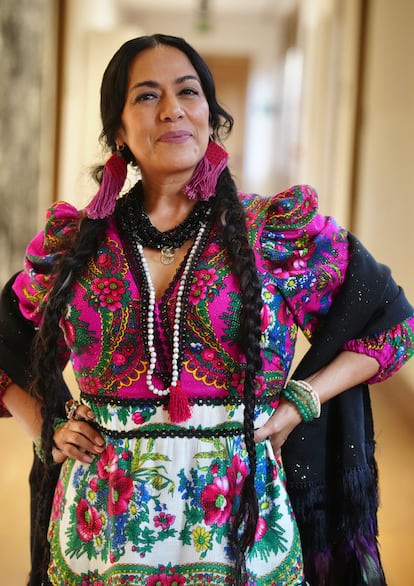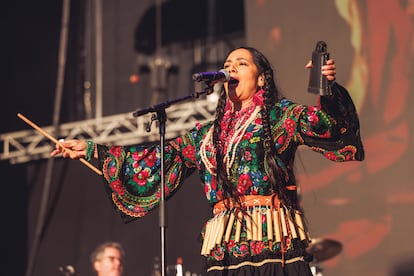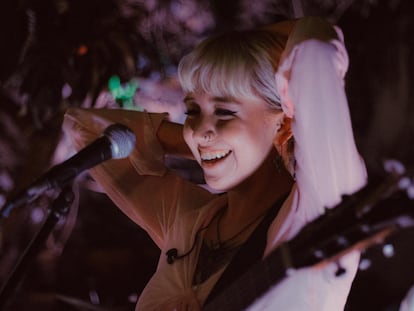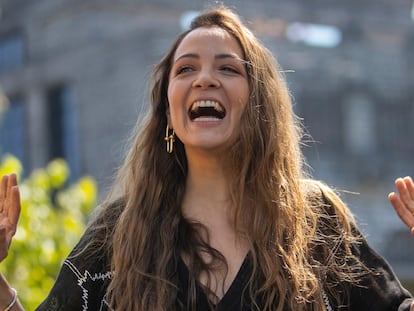Lila Downs: ‘My mother always told me that women should never speak badly about another woman’
She is one of the artists who have best combined present and past. The singer is part of the history of Mexican song, while also embracing current styles. EL PAÍS spoke to her about everything she has learned in her 30-year-long career

Lila Downs exudes strength and presence. Her black hair, carefully gathered in stylish braids, serves as a beautiful tiara. The Mexican singer, who has just landed from her native Oaxaca, is one of the artists who have best combined present and past. She is part of the history of Mexican song, but at no time has ignored the most current styles.
Feminist to the core, champion of Indigenous rights and tradition, Downs has arrived in Spain for a tour that will see her share the stage with artists such as Rodrigo Cuevas, Ara Malikian, Mulatu Astatke and Muchachito Bombo Infierno. Downs is presenting her latest album, La Sánchez, a tribute that encapsulates the best of her work and takes an in-depth look at who she has been and who she is now. A journey in which her mother has always been present.
Question. The title of your album La Sánchez, in some way, refers to your mother, Anita Sánchez. I understand that it is a way of vindicating her and making your connection known. Who is she? I had read that she was a cabaret singer.
Answer. Well, she says that the place where she started was a coffee shop. But my father said it was a cantina. So since childhood there were those two versions and they were always very free in that sense.
Q. Was your mother protective?
A. My mother has always protected me. I think I’ve seen that a lot here too. Women protecting and being like the women who sheltered others. Reality is often very harsh. And my mother is a bit like that, but my mother is also a character, she is a natural biologist. She’s always observing nature.
Q. She lives with you, in your home in Oaxaca, and is 86 years old.
A. And now she’s taking care of my kids. Yes, she drives to the ranch and there they observe the worms, the chickens and the turkeys, because we have some little animals and 16 dogs that she rescued. She is a character, my mother is a character. She is an artist; she makes clay objects, she makes collages. We recently opened a restaurant in Oaxaca and she decorated several corners.
She always taught me to observe women with respect. Since I was little, she told me: “Lila, I think that women should never speak badly about another woman.” And that was revolutionary in my childhood. I think that contributes a lot to me being the artist that I am.
Q. She was married at the age of 14, as was customary in the Indigenous communities of her generation, but she didn’t accept it.
A. A few months later, she escaped and went barefoot to Mexico City, because that was the custom of that time. We are about 14 hours away by car, so it took several days walking to get there. There she worked with a Spanish family, her first job. That greatly influenced her vision and how she raised me.
Then she started to sing a little bit and she told me that she did it when she had had something to drink, because she didn’t have the courage to do it sober. She told me with great affection and respect: “I admire you because you are not afraid to sing on stage.” I was afraid, but I found my husband, my accomplice from my youth, with whom I understood the constancy of music and Zen. I already had it by nature, but I didn’t understand the concept of constantly doing it to create and become another being through music.
Q. What other women artists have influenced you? I think that singers like Lucha Reyes, Lola Beltrán and Flor Silvestre played a decisive role.
A. Indeed. Lucha Reyes, not so much in her way of singing, but as a character, because she was a woman who started singing at a time when men dominated. What’s more, she began to sing challenging music and was an opera singer, something that I also did: I studied opera and then became a popular singer.
She toured Europe as an opera singer, but later became a legendary character, wearing the Mexican Chinese costume and always wearing the shawl. She was from Jalisco, a state with a very strong identity. That left a mark on me forever. I also liked to see her in the shorts of her films, where she put herself on the same level as men. I would say, “I love that.” So she influenced me a lot.
Q. And Lola Beltrán?
A. I admired her a lot vocally and also because I have a deep tone that I inherited from my mother. Leonard Bernstein did a whole anthropological series on how we human beings inherit music, and the first sounds of our lives. My mother has a deep voice and my grandmother also spoke with a deep voice. It’s a bit unusual in Mexico, as women usually have a higher pitch and softer tones.
I loved the movies with Lola and Flor Silvestre. I watched those movies and would say: “I want to be in that world, ride a horse among the agaves and start singing.” It was a love affair with those movies. Unfortunately, I didn’t have the opportunity to meet her. But then Mercedes Sosa began to take a very important place in my life. I was able to record with her. That changed the direction of my music, because I realized that you can write songs with conviction, and that changes everything.

Q. You have taken on countless styles: cumbias, rancheras, boleros, corridos. And all at a stratospheric level. I understand that as an anthropologist, this type of approach to music must be very appealing.
A. Of course, because it represents the variety of our cultural expression and also our environment, our childhood, where we come from. I suffered a lot when I stopped listening to cumbia when I went to the United States. I missed the village loudspeaker. All kinds of music and advertisements were played on those speakers.
In my town, we listened to Rigo Tovar’s cumbias. My peers said: “How horrible! Rigo Tovar, how embarrassing,” because he was associated with the working class. But when I was away, I started to appreciate that music. We also listened to him at my house and my aunts and relatives who came to stay also played it. That’s how I began to compose and respect cumbia. It was difficult for me, because the musicians I worked with said: “Cumbia? How are you going to sing a cumbia? We have studied at the conservatory to return to cumbia.” It was a difficult process, but it has been a beautiful path.
Q. And now, what is your opinion of artists like Peso Pluma, who are from younger generations, but who also take tradition, rework it and appropriate it? In some ways, you are a pioneer of this.
A. I love that these young people from the north [of Mexico] are taking up the corrido [a style of music that became popular during the Mexican Revolution]. It is something that musicians like me, who are always in search of tradition, have tried to work on, especially the harmonies and rhythms of the corrido and the ranchera. They are very difficult to work with, so mixing it with hip hop and blues harmonies is wonderful. I love the sound, I’m passionate about it. I also like the stories of illegality, which are characteristics of the corrido. What I don’t like is misogyny. That is already terrible and we must continue saying that it is unacceptable.
Q. You have lived in the United States and Mexico, you completed your degree in Anthropology in Minnesota in the mid-1990s. How do you see the situation between the two countries, now that you also live in Mexico? Has anything changed with respect to women’s rights?
A. I have seen many musicians, people and women come back from a time when as an artist you could not talk about certain topics. Now we can talk about them freely. But I have also seen that there are still difficult situations for women, especially in rural contexts. That is why I continue to fight and do concerts on behalf of Indigenous and mestizo women. I collaborate in a scholarship where I help these young women.
It has been my contribution to a very interesting project, in which tutoring is the most important part. If you think about it, there is a great difference between the Indigenous world, with its conception of life, and the world of the cities, where the universities are. These young women want to enter the academic world, but if they do not have someone who can translate those social and cultural differences for them, it is not going to work. This project does that on a voluntary basis, and I love participating in volunteer projects. I think this is how we can change the world.
Q. In 2024, it will be 30 years since your first album, Ofrenda. This year also marks another special anniversary: 10 years ago you released Raíz, together with Niña Pastori and Soledad Pastorutti, an important work within your long career. How do you remember the Lila Downs that made that album?
A. I am very happy because I have reunited with that Lila from before. I think time is the gift that time gives us, look back if you have the time to do so. You have to fight for your time and decide on that, and I think it is good for all of us, and for Mother Earth too, to take the time.
It was like in ancient times, in the times of grandmothers. There is something very beautiful in how they told us about how things were. They were so natural, we were not fighting with nature. Although my grandmother was very happy with her plastic bags and buckets, she used to say: “This is what’s good, child, because this way you can store the corn, the beans, all the things that one needs to save in case there is revolution.” She always said it. It’s a balance. The secret of life.
Q. It’s surprising that, given how prepared you are for absolutely everything, you weren’t so involved in the production of your albums until this last one, La Sánchez. What has it been like to take control of what is yours? What has the process of getting to know, experimenting in and working in production been like?
A. It has been a process of learning with my husband, but also of distancing, of realizing my independence and my anger with society and with him. In a couple, sometimes there are two alphas, and that gets complicated. They are life lessons that make you realize that you really want to do things yourself.
Curiously, I lost my husband and it coincides with the fact that this album is the most independent one. Before he died, he decided that jazz was his thing, and that’s why we opened a restaurant that has a forum upstairs, where he performed with his jazz group. It was nice because we became independent as human beings, each one on their own artistic path.
Q. I notice that you take great care in the details of your clothing. I understand the clothes you wear refer to the strong textile tradition in Mexico. How do you forge links with this craftsmanship?
A. My childhood is full of memories of the rebozo [shawl worn in Mexico] which my grandmother used to carry me. It is a rebozo de bolito [made of cotton], very special for its stitch work and its fabric. It is dyed and uses the licat or tie-dye technique, where it is tied and then loosened to create these drawings. The huipil [garment worn by Indigenous women] I wear is also dyed, with indigo from the Sierra Juárez and comes from a beautiful tradition.
I love it because it is very sober, unlike other colorful clothing. It is elegant, refined and beautiful, made of cotton woven on a pedal loom. And what I am wearing over my arms is a work by the maestro Toledo, who left his legacy at IAGO, the Institute of Graphic Arts of Oaxaca. In the city of Oaxaca, there are wonderful art books accessible to any student. What’s more, the building is beautiful and is located in the tourist area of my land. There they have pieces that he designed, covered in gold leaf but made of leather.
Q. I saw that you have a tattoo on your forearm that says “respect.” Do you have any more?
A. I have one more that I got when I went with Maori people to New Zealand, as a reminder of the original. According to anthropologists, they were the first to have permanent tattoos. So here’s the reminder.
Sign up for our weekly newsletter to get more English-language news coverage from EL PAÍS USA Edition
Tu suscripción se está usando en otro dispositivo
¿Quieres añadir otro usuario a tu suscripción?
Si continúas leyendo en este dispositivo, no se podrá leer en el otro.
FlechaTu suscripción se está usando en otro dispositivo y solo puedes acceder a EL PAÍS desde un dispositivo a la vez.
Si quieres compartir tu cuenta, cambia tu suscripción a la modalidad Premium, así podrás añadir otro usuario. Cada uno accederá con su propia cuenta de email, lo que os permitirá personalizar vuestra experiencia en EL PAÍS.
¿Tienes una suscripción de empresa? Accede aquí para contratar más cuentas.
En el caso de no saber quién está usando tu cuenta, te recomendamos cambiar tu contraseña aquí.
Si decides continuar compartiendo tu cuenta, este mensaje se mostrará en tu dispositivo y en el de la otra persona que está usando tu cuenta de forma indefinida, afectando a tu experiencia de lectura. Puedes consultar aquí los términos y condiciones de la suscripción digital.
More information
Archived In
Últimas noticias
Most viewed
- David King, chemist: ‘There are scientists studying how to cool the planet; nobody should stop these experiments from happening’
- Reinhard Genzel, Nobel laureate in physics: ‘One-minute videos will never give you the truth’
- Mexico completes its trade shift with the entry into force of tariffs on China and countries without trade agreements
- Oona Chaplin: ‘I told James Cameron that I was living in a treehouse and starting a permaculture project with a friend’
- Sinaloa Cartel war is taking its toll on Los Chapitos











































